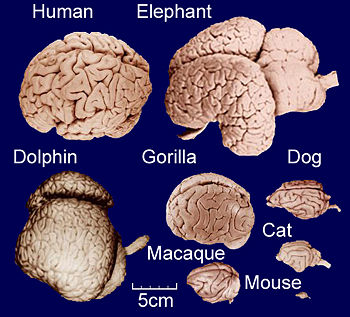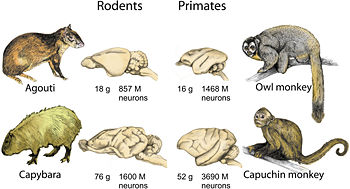Brain size
This article uses direct referencing.

Comparative anatomy of adult brains from various vertebrate species, highlighting the gradual differences in brain size and gyrification.

Since the brain has enlarged considerably during hominid evolution, brain size is a central term in many discussions related to cognitive evolution, intelligence and a number of brain disorders, especially microcephaly. To compare different brains, several indicators of brain size have been used. These include absolute brain size, relative brain size (normalized by body size or weight), and the encephalization coefficient.
Determinants of brain size
A number of parameters have been found to be involved in the determination of brain size. These include the genes microcephalin (MCPH1) and ASPM (MCPH5; for overview, see Stern and Woods, 2006 and Tang 2006; contradictory evidence is presented in Ali & Meier, 2008), habitat density (at least in bats, cf. Safi et al., 2005), and pelvic size in human females (cf. Ridley 1995) as a limiting factor.
Correlates of brain size
Further variables interact with brain size but cause and effect in these relationships have not yet been clearly identified. This is the case with migratory distance in birds (Sol et al., 2010), the maximum rate of population increase (Isler & Van Schaik, 2009), the basal metabolic rate (Isler & van Schaik, 2006a), the flight musculature (at least in birds, cf. Isler & van Schaik, 2006b), the wing area (at least in bats, cf. Safi et al., 2005), and some cognitive traits like kleptoparasitism (Morand-Ferron et al., 2007).
Effects of brain size
Brain size, in turn, was found to have an effect on gyrification (cf. Hofman 1989 and Casanova et al., 2004) and the glia-neuron ratio (cf. Sherwood et al., 2006).